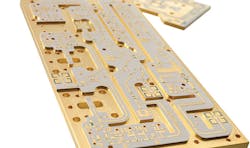Handling Heat in High-Frequency PCBs
Heat can be a danger to the most ruggedized printed-circuit boards (PCBs)—whether from within the devices on the PCB or from beyond—in the working environment. Fortunately, John Priday, Chief Technology Officer of Teledyne Labtech, has managed practical research on the effects of heat on PCBs and how to provide thermal management for improved reliability even under hostile thermal environments.
The results of the research are reported in a company application note, “Thermal Management in High Performance RF and Microwave PCBs,” available for free download from the company’s website. Teledyne Labtech, a Teledyne Defense Electronics company, will be on hand as an exhibitor at the 2019 IEEE International Microwave Symposium (IMS) in the Boston Convention Center, June 4-6, 2019 (Booth 1124).
Military and aerospace electronics environments are typically evaluated for wide operating temperature ranges, although constraints such as reduced size, weight, and power (SWaP) can apply even to large high-power amplifiers and antenna arrays. Meeting thermal-management requirements are becoming more difficult with the increasing power densities of active devices, such as power transistors based on gallium-nitride (GaN) semiconductor substrates. The high-power capabilities of such small devices require reliable dissipation of excess heat to avoid hotspots and heat buildup on a PCB.
Plated-through holes (PTHs) and other structures are added to PCBs to minimize heat buildup around active devices such as GaN transistors. (Courtesy of Teledyne Defense Electronics)
Traditionally, plated through-holes (PTHs) are used in a PCB to transfer excess heat from the area of an active device to a heatsink or other structure for dissipating the heat. But engineers at Teledyne have applied “coin” technology to PCBs, in effect adding heatsinks throughout the PCB, as an effective approach to thermal management even with high-power-density GaN power transistors. Work continues on the exploration of different materials in the quest for the highest thermal conductivity possible to shift heat from an active device. It’s all in the effort to extend the operating lifetimes of the device as well as the PCB.
About the Author
Jack Browne
Technical Contributor
Jack Browne, Technical Contributor, has worked in technical publishing for over 30 years. He managed the content and production of three technical journals while at the American Institute of Physics, including Medical Physics and the Journal of Vacuum Science & Technology. He has been a Publisher and Editor for Penton Media, started the firm’s Wireless Symposium & Exhibition trade show in 1993, and currently serves as Technical Contributor for that company's Microwaves & RF magazine. Browne, who holds a BS in Mathematics from City College of New York and BA degrees in English and Philosophy from Fordham University, is a member of the IEEE.


